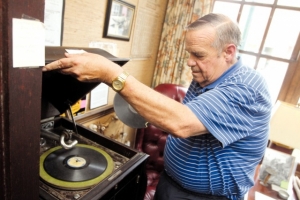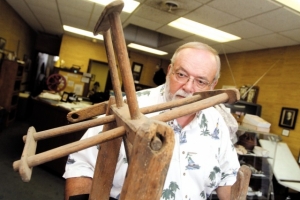Collection gives visitors a look at Fremont's early days
By Aaron Moore
Published in News on July 19, 2012 1:46 PM

News-Argus/TROY HERRING
Jimmy Ballance showcases an old record player that sits in the Fremont Heritage Museum. The museum, which is open the second and fourth Sundays of the month from 2 to 4 p.m., houses historic items ranging from photographs to old sports memorabilia that detail the history of Fremont and its surrounding area.
FREMONT -- Jimmy Ballance didn't take the field when a group of Fremont area soldiers fresh home from World War II took on a group of major league baseball players in 1947 and almost won.
But he can tell you all about it.
"We didn't win, but we played them a good game," Ballance said. "That brought some civic pride to Fremont."
Ballance said the major league players were touring in the off-season, and they stopped by Fremont to play with the local boys.
He knows all about it because it's just one of the exhibits in the Fremont Heritage Museum on Main Street next to the Town Hall -- a collection of locals' memories and keepsakes stretching all the way back to the 1700s.
Museum president John Pippin said the museum is special because it has a lot of different stories -- fragments of people's lives that don't fit into history books.
"There's so many different things with different stories," Pippin said. "It's just memories of Fremont."
Ballance, who was the museum's first president and is part of the Fremont Historical Society along with Pippin, said he enjoys preserving the town's history.
"As the old expression goes, you can't know where you're going unless you know where you've been," Ballance said.
Ballance and Pippin both recall when Fremont was a thriving, self-contained haven of small businesses and surrounding family farms.
"Times have changed," Ballance said. "People moved to the city because society changed, and you couldn't survive on a small family farm anymore."
But in the 1940s and 1950s, Ballance said, there was a business in every building on Main Street and people often stayed out until late in the evening just to visit with their neighbors.
"On Saturday afternoons, the sidewalks would be so crowded, it would be like the mall at Christmas time," he said.
Children and young couples would also flock to the movie theater, which is now closed, to buy 10-cent popcorn and watch westerns and cartoons.
"Fremont was basically self-sufficient," Pippin said. "People did not go to Goldsboro, Wilson everyday. They bought their supplies here. Most people made their living on a farm. People farmed their own meat, grew their own vegetables. They only went shopping for some canned things, things they couldn't produce."
During the fall, winter and spring, he said, the Fremont School became the town's center of entertainment. People went there for plays, music, carnivals and basketball games.
Although Ballance said society has become more mobile, Fremont's small-town atmosphere is still alive and well.
"There's certain aspects of Fremont that have not changed," he said. "There's a slight change, but not much."
And although Fremont once had three car dealerships, six gas stations, a movie theater and at least four grocery stores, Ballance said it hasn't shrunk; people have just started to move around more.
That's why he and Pippin said it's important to hold on to memories of old times -- especially for the sake of the young people who might not know the town's history.
He held up a wooden yarn-spinning machine from the 1700s.
"Young people seeing that yarn winder, what their ancestors used, instead of an iPod -- it makes them appreciate where they come from," Ballance said.
He added that he teaches his grandchildren to use rotary telephone dials when they come to his house, just so they'll know what it's like.
Ballance said what he likes most about the museum is not just the history, it's the fact that everything in it was donated from local families.
The walls are lined with black-and-white photos of farmers, store fronts and World War II veterans. There is an old phonograph and wooden school desks with holes for ink bottles in them -- all relics of days gone by.
And although people might not ride the train or play baseball in cow pastures anymore, Ballance and Pippin said things haven't gotten worse -- just different.
Anyone who wants to see how different can stop by the museum, which is open every second and fourth Sunday from 2-4 p.m.

